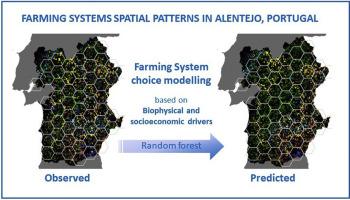Agricultural Systems ( IF 6.6 ) Pub Date : 2021-04-10 , DOI: 10.1016/j.agsy.2021.103140 Paulo Pacheco de Castro Flores Ribeiro , José Manuel Osório de Barros de Lima e Santos , Maria João Prudêncio Rafael Canadas , Ana Maria Contente de Vinha Novais , Francisco Manuel Ribeiro Ferraria Moreira , Ângela Cristina de Araújo Rodrigues Lomba

|
CONTEXT
Efforts to bring together landscape analysis and farming systems have failed to explain the drivers behind their spatial distribution. Since agricultural landscapes are an outcome of farmers' decisions, understanding the role of socioeconomic and biophysical drivers of such decisions is essential for policy-making targeting landscape-level provision of public goods and ecosystem services from agriculture.
OBJECTIVE
Aiming to better understand the role of these drivers, we focused on a region dominated by agricultural use, with extensive variability in biophysical and socioeconomic conditions. A typology of farming systems was derived from spatially explicit farm-level data provided by the Portuguese agency responsible for Common Agricultural Policy payments, for 2017. Farms were thoroughly characterized through relevant biophysical and socioeconomic variables considered as potential drivers of farming systems.
METHODS
A random forest approach was used to develop a farming system choice-model, dependent on those biophysical and socioeconomic variables. Variable importance measures and partial dependence plots were used to explore the role of these variables in explaining the spatial distribution of farming systems and to predict spatial patterns at the landscape scale.
RESULTS AND CONCLUSIONS
Results showed that both biophysical and socioeconomic drivers play a significant role in the spatial distribution of most agricultural systems. Its importance, however, varies significantly across farming systems, being crucial for some and almost irrelevant for others. Farm size and climate have proved to be the most relevant drivers for most farming systems. Overall, our approach proved to be quite accurate in predicting patterns of farming systems at the landscape scale.
SIGNIFICANCE
The proposed framework has shown great potential as a tool to support information-based policy design to improve agricultural landscape planning, by linking farm-level management decisions with the provision of socially valued public goods from agriculture, perceived at the landscape-level.
中文翻译:

解释耕作系统的空间格局:基于社会经济和生物物理驱动因素的农场层面的选择模型
语境
将景观分析和耕作系统结合在一起的努力未能解释其空间分布背后的驱动因素。由于农业景观是农民决策的结果,因此了解此类决策的社会经济和生物物理驱动力的作用对于以景观水平提供农业公共产品和生态系统服务为目标的决策至关重要。
客观的
为了更好地了解这些驱动因素的作用,我们将重点放在了以农业利用为主的地区,该地区的生物物理和社会经济状况差异很大。耕作制度的类型是从葡萄牙负责共同农业政策付款的机构提供的空间明确的农场级数据得出的,该数据是2017年的。农场被认为是耕作制度的潜在驱动因素的相关生物物理和社会经济变量来进行全面表征。
方法
取决于那些生物物理和社会经济变量,采用了随机森林方法来发展农业系统的选择模型。变量重要性度量和部分依赖图被用来探索这些变量在解释耕作系统空间分布中的作用,并预测景观尺度上的空间格局。
结果与结论
结果表明,生物物理和社会经济驱动因素在大多数农业系统的空间分布中都起着重要作用。然而,其重要性在整个农业系统中差异很大,对某些系统至关重要,而对另一些系统几乎无关紧要。事实证明,农场规模和气候是大多数农业系统中最相关的驱动力。总体而言,我们的方法在预测景观尺度上的耕作模式方面非常准确。
意义
拟议的框架通过将农场一级的管理决策与从农业上提供具有社会价值的公共产品联系起来,在景观一级被视为具有支持基于信息的政策设计以改善农业景观规划的工具的巨大潜力。


























 京公网安备 11010802027423号
京公网安备 11010802027423号